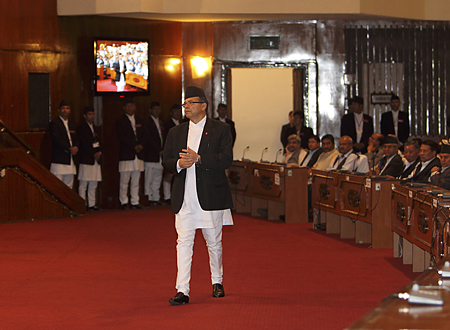
Nepalese Prime Minister Jhala Nath Khanal arrives to announce his resignation at the parliament in Kathmandu August 15, 2011. (Photo: Navesh Chitrakar / Reuters)
Nepal’s difficult journey toward full democracy came through struggle, blood and tears: following a decade long civil war that claimed some 13,000 lives, a peace process initiated in 2006 sought to remake the Himalayan nation. But, five years later, things are lurching simply toward farce.
Current Prime Minister Jhalanath Khanal resigned his post August 15, citing difficulties in keeping his fragile government intact and getting fellow lawmakers to move planned reforms forward, most specifically the adoption of a Constitution, essential if anything is to be achieved by Nepal’s new secular republic (the peace process did away with the authority of the nearly three century-old monarchical dynasty). Yet Khanal himself had only been in his position since February. For seven months preceding that, impoverished Nepal didn’t even have a Prime Minister.
At the root of the dysfunction are the petty interests and rivalries of the country’s three main political parties: the establishment Nepali Congress, the Maoists, who traded their guerrilla fatigues for suits and offices in the capital, and Khanal’s UML, a center-left party. They alongside other weaker factions were charged to find consensus over reforms, devise steps to integrate the earlier royalist Nepali army with thousands of Maoist fighters still penned in militant camps, and figure out how to redistribute power and governance in a complicated, multi-ethnic state of 40 million that for decades was ruled heavy-handedly out of the palaces of Kathmandu.
Yet little has been achieved in over three years. An International Crisis Group report from April spells out the intertia:
The major elements of the peace process, namely integration [of the military] and the new constitution, have been reduced to bargaining chips in the struggle for the immediate benefits of power sharing and longer-term re-alignments between and within parties.
The wrangling over what will follow this current government is set to continue — a distasteful feature of parliamentary politics that’s all too common in South Asia — only deepening the sense of paralysis and crisis that has gripped the country. A delegation from Beijing, fronted by Zhou Yongkang, a senior figure in the Chinese Communist Party’s governing Politburo, arrived in Kathmandu yesterday, offering platitudes over the Nepalese need to move forward with “dialogue” and consensus. Privately, of course, one can be sure sterner messages were conveyed — China fears instability in Nepal could spur troubles in Tibet, just north of the border. India, meanwhile, which traditionally casts a longer shadow across Nepal, has remained conspicuously “aloof” during the current crisis. A geo-political tug of war between these two rising powers will hardly help the poor country caught in between, one which has a dizzying array of factions and conflicts of its own to resolve.
All the while, Nepal’s economy lurches in the doldrums, propped up by aid handouts from increasingly exasperated foreign donors. Power and fuel shortages routinely grip Kathmandu, bringing daily life to a halt. Nepal’s growth rate remains middling, while countless Nepalese are forced to abandon their country for jobs in the Gulf states, India, and further afield in Southeast Asia. In 2010, over a fifth of Nepal’s GDP came from remittances sent back home by hundreds of thousands toiling abroad. Looking home, many must wonder what future, if any, is taking root in the rugged, conflict-torn land.

